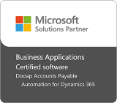In our recent blog Making the Business Case for AP Automation we presented a company-wide business case for AP automation. Once you’ve made the business decision to automate your AP operations to gain visibility, efficiencies and cost savings, how do you get IT on board with your decision?
The first step is to lay out your options.
By this point, you’ve likely ruled out the “do nothing” option because of the associated costs in terms of time, money and delayed payments as well as lack of visibility and control over your finances. That leaves you with the buy vs. build decision.
If you build your own solution you may save on upfront costs because you will own the solution. In addition, there are a variety of low-code technologies to build on, like Microsoft Power Platform with Power Automate, AI Builder, PowerApps and Power BI. However, this approach will likely turn out to be penny-wise, pound-foolish because you’ll end up with a partially automated solution which is built from several building blocks. The Power Platform is a great innovation but it does not enable the robust touchless end-to-end AP process automation and the productized end-user experience that out-of-the-box solutions do, the native feature-rich Mobile App being one example. You’ll also be on your own when it comes to upgrades and maintenance – which require greater IT involvement. Moreover, the licensing of the Power Platform components is complex, a combination of fees per user/app/flow/etc. All of this ends up costing your company more in terms of time and money and takes IT away from other initiatives that support your business. Let’s face it, developing world-class AP automation solutions is not your company’s core strength or business, thus it’s also not a strategic investment.
You’re left with the option of buying, which makes sense for most companies. Today’s AP automation solutions are mature and offer advanced capabilities right out of the box, starting from invoice intake and capture, through to invoice payment. They are based on decades of best practices gathered across all types of companies and address a wide range of user needs, from the Finance team to invoice approvers on the go.
And, unlike many other types of automation, AP automation solutions are IT-lite, meaning that the time IT needs to spend in implementing, upgrading, or maintaining these solutions is little to none. Technical implementation of these solutions takes hours rather than days or weeks, which is quite a different story compared to the build option.
The IT Checklist
When you’ve decided to buy there are still criteria to consider, since AP automation solutions in the market vary from one another. Here are six IT and end-user criteria that organizations should consider when evaluating a solution:
- Ease-of-use. End-users expect the same ease-of-use in their business solutions that they are used to in their consumer apps. The easier a solution is, the more effectively it will be adopted, and the more satisfied end-users will be. Look for an intuitive graphical user interface (GUI), and solutions that make processing the invoices for different user roles as easy as possible.
- How much training is needed? If a solution is easy to use, the time required for training should be minimal.
- Support. What kind of support is provided by the vendor, both for on-boarding the new digital process and for ongoing needs? Pay special attention to a vendor’s expertise and responsiveness. Moreover, ask the vendor how much involvement is needed from your Dynamics partner.
- Compatibility with your ERP. This is an important criterion that will determine whether integration, upgrades and ongoing maintenance are easy or difficult. It is essential that the solution is aligned with Microsoft Dynamics 365 architecture and upgrade cadence. Thus, make sure the solution is certified by Microsoft. You can validate this by visiting Microsoft AppSource Marketplace.
- Security. Another benefit of a certified solution is that it fulfills the security and quality standards determined by Microsoft.
- Is the Mobile App native or browser-based? A native app provides greater user experience. Also, make sure that mobile app includes the critical functionalities end-users need, like being able to edit coding for non-PO invoices and to see the full invoice history.
When you have an easy-to-use, full-featured AP automation solution that is seamlessly integrated with your ERP, the role of IT in day-to-day operations, and even implementations and upgrades, will be minimal to none. Instead, IT serves as a critical gatekeeper to ensure the new solution fits in with your technical architecture and roadmap. That way, IT can do what it does best, and will have time to focus on the core technology needs and strategic initiatives of your organization, while end-users can enjoy a world-class user experience. It’s that simple.
Find the best AP Automation solution for your organization.








